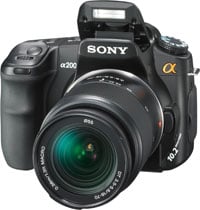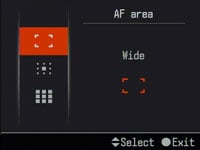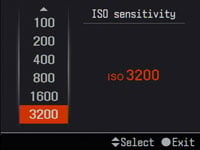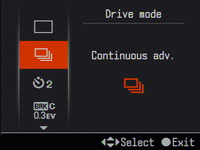Sony Alpha DSLR-A200
-
-
Written by Gordon Laing
Sony Alpha DSLR-A200 lens and stabilisation
The Sony Alpha DSLR A200 employs an A-mount for lenses and is compatible with the complete range of Sony lenses and third party models designed for the Sony or Minolta AF systems, including Sony’s DT models. Like the A700 before it, the polished metal surface of the lens mount extends a few millimetres beyond the trademark Alpha orange ring – see photo.
All lenses attached to the A200 can exploit the camera’s built-in Super SteadyShot stabilisation, and since the A200 employs the same physically sized sensor as previous Alphas, all lenses effectively have their field of view reduced by 1.5 times.
The Alpha A200 will typically be sold in a kit with the Sony DT 18-70mm lens. This is the same model supplied with the A100, and offers a slightly longer range than the typical 18-55mm lenses supplied in other kits. The build quality is ok for a budget bundle, but like most kit lenses, there’s not much of a manual focusing ring to speak of, and both it and the end element rotate while focusing.
 |
We tested our A200 with the higher-end Sony Carl Zeiss 16-80mm lens, but will update this page with coverage examples using the DT 18-70mm when retail kits become available. For a preview though, check out our Sony Alpha A100 review where the coverage shown with the DT 18-70mm will be identical to what you’d get with the A200 – although the colours and tone may vary.
Like all Alpha DSLRs, the A200 is equipped with sensor-shift image stabilisation to combat camera-shake. This moves the entire sensor platform in two axes and is branded by Sony as Super SteadyShot. With the A200, Sony claims improved performance over the debut A100, with between 2.5 and 3.5 stops of compensation depending on the lens and shooting conditions.
As with all sensor-shift stabilised solutions, the major benefit is that it works with any lens you attach, new or old, wide or long, prime or zoom. The downside is that you won’t see the stabilising effect through the optical viewfinder, which can be annoying when framing at longer focal lengths. Like other Alphas, there are at least indicators in the viewfinder which show how hard the system’s working, or when it’s gone beyond its capabilities.
To test the effectiveness of our A200’s built-in stabilisation we took a serious of photos with the 16-80mm zoomed-into an equivalent of 120mm where traditional photographic advice would recommend a shutter speed of 1/125 to eliminate camera shake. Our sequence started at 1/125 and reduced by one stop each time until 1/4.
Sony Alpha DSLR-A200 Super SteadyShot off / on | ||
 |  | |
100% crop, 16-80mm at 80mm, 1/15, 100 ISO, SSS off |
100% crop, 16-80mm at 80mm, 1/15, 100 ISO, SSS on | |
Without Super SteadyShot, the slowest shutter speed where we could achieve a sharp image was at 1/60, whereas with Super SteadyShot we achieved a sharp result down to shutter speeds of 1/15. A shutter of 1/15 corresponds to three stops of compensation over the 1/125 speed that conventional photographic advice would suggest for an equivalent focal length of 120mm, although only represents two stops over what we personally achieved without it under the same conditions. As always, the lens, conditions and the photographer themselves can produce different results.
Either way, while we didn’t measure the maximum 3.5 stops claimed by Sony in this particular example, it’s still clearly a very useful facility to have built-into the camera – especially as it works with any lens you attach.
Sony Alpha DSLR-A200 focusing
The Alpha A200 is equipped with the same 9-point AF system as its predecessor with a centre cross sensor, and like earlier Alphas, the system can be started as you look through the viewfinder; this can indeed save time, but many DSLR traditionalists will prefer to switch it off and go for a half-press of the shutter release instead.
 |
 |
Like the earlier A100, you’ve the choice of single-shot AF-S, continuous autofocus AF-C, or a hybrid AF-A mode which automatically switches between AF-S and AF-C. Unlike the higher-end A700, there’s no AF clutch on the back of the A200, so you’ll need to switch from AF to MF by the lens mount to disengage the focusing motor for manual focusing.
Sony’s fitted a higher-torque AF motor to the A200 and claims an improvement in speed over the A100 of 1.7 times. In use the A200 certainly feels quicker than its predecessor and also focuses a little more quietly too, although it’s far from the virtual silence of Canon’s USM, Nikon’s SWM or Sony’s own SSM system – you can see and hear an example in our A200 video tour.
Sony Alpha DSLR-A200 anti-dust
|
Like all Alpha DSLRs to date, the A200 uses its sensor-shifting mechanism to double-up as an anti-dust system. This vibrates the sensor during power-off in an attempt to shake-free any foreign particles. The sensor filter also has an anti-dust coating.
Following our usual DSLR torture-test we left our A200 face-up without a lens, inside and outside for ten minutes each, before powering it up and down twice, then searching for dust; we can’t know how much dust entered the body during this time, nor even how much was present to start with, but we know such a process would result in dust being a problem for most models.
We then took a series of photos at every aperture setting of a plain white surface at close range with the lens zoomed-in and focused to infinity. Dust marks normally become most apparent at the smallest apertures (eg f16 and f22), but it’s also important to test at more common apertures.
Sony Alpha DSLR-A200 dust example at f22: normal / with levels | ||
 |  | |
50% crop, 16-80mm at 80mm, f22 |
50% crop, 16-80mm at 80mm, f22, Auto levels | |
At f22, four dust marks were quite visible, and we’ve shown a 50% crop of two close marks above; the other two marks were slightly darker. At f16 and f11, these grew larger and more diffused, but didn’t become truly hard to see until you were working at apertures of f8 and above.
So like the A100 before it, we’d say the A200’s anti-dust systems are far from infallible and if you change lenses regularly, you’ll need to rely on the manual cleaning technique of opening the shutter and using a blower.
Sony Alpha DSLR-A200 sensor and processing
The Alpha A200 is equipped with the same 10.2 Megapixel CCD sensor as its predecessor, measuring 23.6×15.8mm. It generates 3:2 aspect ratio images with a maximum resolution of 3872×2592 pixels and there’s the choice of two lower resolutions at 5.6 and 2.5 Megapixels respectively. A new cropped 16:9 aspect ratio is available in 8.4, 4.7 and 2.1 Megapixels.
 |
 |
 |
Images can be saved with Standard or Fine JPEG compression, or recorded as a RAW file either by itself or accompanied with a JPEG. Best quality Large Fine JPEGs typically measure between 2.5 and 5.5MB each, while RAW files measure between 10 and 13MB each. There’s no dedicated button for the quality settings, but it’s easy to adjust them using the Function menu – see previous page.
 |
 |
While the earlier A100 topped-out at 1600 ISO, the new A200 offers sensitivity between 100 and 3200 ISO, with optional High ISO noise reduction at 1600 ISO and above. Long exposure noise reduction is also optional, and if enabled, applies to exposures of one second or longer; you can see how the A200 performs across its sensitivity range in our A200 Results and A200 Gallery pages.
 |
Colour, contrast and sharpness are applied using a number of Creative Styles, chosen from the main menu system. Along with the default Standard setting are Vivid, Portrait, Landscape, Night View, Sunset, Black and White and Adobe RGB; in the colour modes you can adjust contrast, saturation and sharpness in a range of +/-3 steps, but there’s no filters for Black and White.
Like other Alphas, the A200 is equipped with Sony’s D-Range Optimiser feature which can adjust the tonal range as you record the image. Unlike the broad array of options on the A700 though, the new A200 has just three: D-R Off, D-R Standard, and D-R+. We used the default D-R Standard for all our test shots, and will publish a comparison of the three modes when we receive a retail A200.
Sony Alpha DSLR-A200 continuous shooting
 |
The Sony Alpha A200 offers one Continuous Shooting mode rated at 3fps; Sony quotes a maximum buffer of three frames in RAW+JPEG mode, six in plain RAW mode, and no limit for recording JPEGs.
To put this to the test we fitted our test A200 with a high-speed Lexar Professional UDMA 4GB 300x CF card. We fired-off 32 Fine JPEGs (100 ISO / DRO Standard / AF-S) in 12 seconds before the A200 slowed briefly, corresponding to a rate of around 2.7fps. Switching to RAW mode saw eight frames in just under three seconds before the camera slowed – this corresponded to 2.8fps, although it did keep shooting beyond the six frame buffer quoted by Sony.
Support this site by checking prices above or shopping via our affiliate stores |




